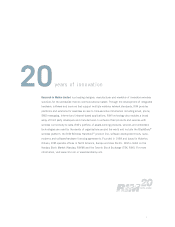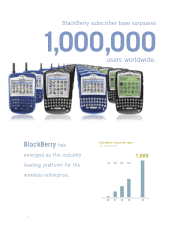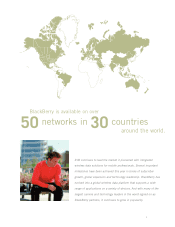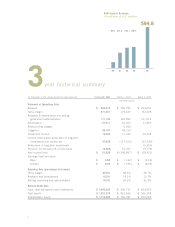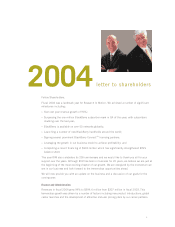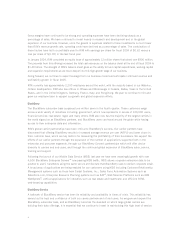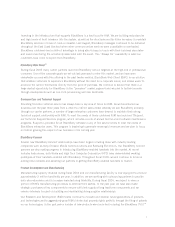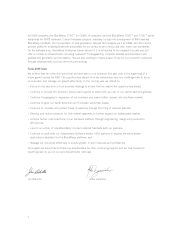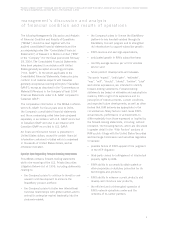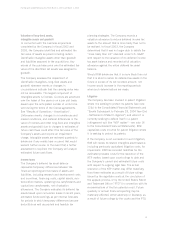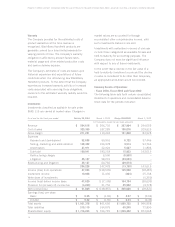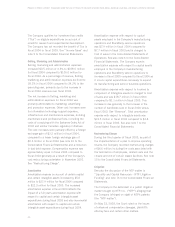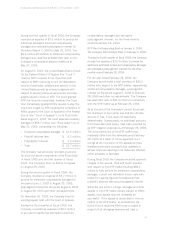Blackberry 2004 Annual Report Download - page 13
Download and view the complete annual report
Please find page 13 of the 2004 Blackberry annual report below. You can navigate through the pages in the report by either clicking on the pages listed below, or by using the keyword search tool below to find specific information within the annual report.
11
For the years ended February 28, 2004, March 1, 2003 and March 2, 2002
personal organizer including contact and calendar
functionality, which can synchronize with the user’s
desktop PIM system, and web-browsing capability.
RIM has developed various models of its BlackBerry
Wireless Handheld, including models that integrate
a mobile phone with other wireless data and PIM
features.
RIM generates revenues from service billings to
its BlackBerry subscriber base. The Company’s
service revenue is generated in one of two forms:
(i) a monthly infrastructure access fee to a carrier/
distributor where a carrier or other distributor bills
the BlackBerry subscriber; or (ii) a monthly service
fee charged by RIM directly to end-customers where
RIM has purchased airtime from certain carriers and
resold it directly to BlackBerry subscribers.
An important part of RIM’s BlackBerry wireless
solution is the software that is installed on desktop
personal computers and/or at the corporate server
level. Software revenues include fees from
(i) licensing RIM’s BlackBerry Enterprise Server
(“BES”) software; (ii) client access licenses
(“CALs”), which are charged for each subscriber
using the BlackBerry service; and (iii) maintenance
and upgrades to software. BlackBerry Connect is
RIM’s licensing program that enables mobile device
manufacturers to equip their handsets with the
integrated ability to connect to a BES and RIM’s
BlackBerry Web Client-related services using the
same wireless architecture and infrastructure that is
being used by RIM’s BlackBerry Handheld
customers. The BlackBerry Connect licensing
program, which has become an increasingly
important component of the Company’s strategy, is
designed to help provide a more open, global
platform and address the distinct needs of end
users, IT departments, carriers and licensees.
Revenues are also generated from sales of radio
modems to original equipment manufacturers
(“OEMs”), non-recurring engineering services
(“NRE”), accessories, technical support and repair
and maintenance programs.
Critical Accounting Policies and Estimates
General
The preparation of the Consolidated Financial
Statements requires management to make estimates
and assumptions that affect the reported amounts of
assets, liabilities, revenues and expenses and the
disclosure of contingent assets and liabilities. These
estimates and assumptions are based upon
management’s historical experience and are believed
by management to be reasonable under the
circumstances. Such estimates and assumptions are
evaluated on an ongoing basis and form the basis
for making judgments about the carrying values of
assets and liabilities that are not readily apparent
from other sources. Actual results could differ
significantly from these estimates.
The Company’s Critical Accounting Policies have
been reviewed and discussed with the Company’s
Audit Committee.
Revenue recognition
The Company recognizes revenue when it is realized
or realizable and earned. The Company considers
revenue realized or realizable and earned when it
has persuasive evidence of an arrangement, the
product has been delivered or the services have
been provided to the customer, the sales price is
fixed or determinable and collectibility is reasonably
assured. In addition to this general policy, the
following are the specific revenue recognition
policies for each major category of revenue.
Hardware
Revenue from the sale of BlackBerry Handhelds is
recognized when title is transferred to the customer
and all significant contractual obligations that affect
the customer’s final acceptance have been fulfilled.
Provisions are made at the time of sale for
warranties, royalties and estimated product returns.
For hardware products for which the software is
deemed not to be incidental, the Company
recognizes revenue in accordance with the American
Institute of Certified Public Accountants Statement
of Position 97-2, Software Revenue Recognition
(“SOP 97-2”).


